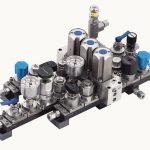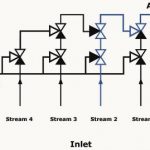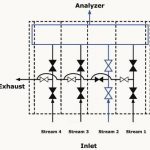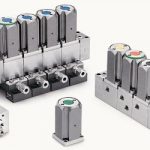Sample stream selection assemblies have leapt forward as field analytical instrumentation becomes more and more sophisticated. They have advanced from bulky, maintenance-heavy systems to miniature, modular designs that offer easy servicing and improved performance. To ensure efficient operation of the analytical system, considerable care is essential when choosing the sample stream selection assemblies.
To minimise system costs, many facilities utilise a single, automated process analyser to evaluate multiple sample streams in quick succession. These systems often resort to a stream selection assembly, which selectively directs multiple sample streams to a shared passage line leading to the single analyser. Amongst other things, they must:
- Automatically select a given stream in minimal space,
- Maintain the sample’s integrity by avoiding cross-stream contamination, and
- Rapidly purge old sample material while moving the new stream to the analyser.
Various stream selection assemblies based on double block-and-bleed (DBB) valve configurations are available. The most efficient systems are compact with constant flow properties, short purge times, low valve actuation pressures and enhanced safety characteristics. In addition, user-friendly assemblies offer visual actuation and flow path indicators, ANSI-ISA 76.00.02 compatibility, and easy maintenance and trouble-shooting capabilities (fig. 1).
Sample stream technology
In older systems, individual process lines typically meant a single ball valve per line. All streams then shared a common passage to the collection device or analyser. As a new stream passes through the common analyser passage, it must remain intact and free of any residue from previous samples. This new stream must run through the system for a defined period of time to purge old sample material. Cross-stream contamination may occur in addition, usually as a result of internal leakage or cross-port leakage in valves. Deadlegs, or trapped volumes, represent a further risk. Sample contamination used to be common in single ball valve systems due to deadlegs and leaking valves. To overcome these inadequacies, system manufacturers turned to two different designs based on double block-and-bleed (DBB) configurations – a traditional design and a cascading one. The primary difference between these alternatives lies in the flow path of sample material through the assembly on its way to the common analyser passage.
In a traditional DBB system, each stream has two valves in series to block the sample flow to the common analyser passage. The streams take a direct route from the process line to the passage. When the block valves are closed, a bleed valve is opened to vent the volume between them to the atmosphere or to a collection device. If the first block valve leaks, the sample flows to the vent rather than cross-contaminating other streams in the assembly. Deadlegs may still be a potential problem if users do not make adequate provision for system purging.
A cascading DBB configuration, in which one stream flows through the bottom bleed valve of an adjacent stream or streams, avoids deadlegs by purging the system through the flow path. When stream 2 is running to the analyser as shown in figure 2, it flows through a set of block-and-bleed valves and then through the bleed valve of stream 1 before reaching the line to the analyser. Stream 2 forces out any residual sample material from stream 1. When stream 2 is running, its bleed valves are closed, reducing potential sample contamination from other streams.
Both the traditional and cascading DBB designs rely on instrument ball valves for their high flow, ease of actuation, and relatively simple use and maintenance. However, these ball valve assemblies require significant space due to the large number of fittings, tubing and valves needed to accomplish sample stream selection. They are bulky and difficult to maintain.
Advances in sample stream assemblies
Recent advances have led to modular valve assemblies that accommodate multiple process streams in a limited amount of space. Valve modules with DBB functionality control each stream individually, operating as both shut-off and stream selector valves (fig. 3). Based on a modular technology concept, these valves house multiple functions in one unit. End users can now integrate double block, bleed and actuation functions in a single module instead of resorting to several instrument ball valves. The total space needed and the overall installation time are thus reduced. As system requirements change, modules can be added or removed, also saving time.
With modular stream selection assemblies, system designers still have a choice between a traditional or a cascading DBB configuration and an integrated flow loop design. Modular cascading designs – like their non-modular counterparts – move sample material through the bleed valves of downstream valving on the way to the analyser passage. This flow path results in inconsistent flow rates from one stream to another. The primary stream – stream 1 in figure 2 – has direct access to the outlet. As the streams move farther away from the outlet, the flow path becomes tortuous. The sample stream flow is therefore diminished the greater the distance between the outlet and the stream. The purge times for these streams are also longer. The modular, integrated flow loop design eliminates the problem of inconsistent flow. A flow loop is incorporated in the base blocks of the modules. Double block-and-bleed valves open straight into the flow loop, which provides a direct route to the analyser as shown in figure 4. Sampling and purging are streamlined. The flow rates of all streams are constant, regardless of which stream is running. Constant stream flow rates allow designers to set constant purge and analysis times for all streams. The varying flow rates found in cascading DBB designs can lead to wasted product, as the system may be set to purge each stream according to the length of time it takes to purge the slowest stream. The longer overall analysis time may also encourage inefficiencies when it comes to detecting contaminated process streams.
Additional design considerations
Additional points to be considered when choosing the best modular device for an analytical instrumentation application include system compatibility, safety issues and the assembly’s user-friendly characteristics. Designers are likely to pay attention to the following aspects:
- Built-in pneumatic actuators in automated stream selection assemblies provide repetitive shut-off with fewer potential leak points than conventional systems. Common industry practices dictate air system actuation pressures of 2.7 bar (40 psig).
- An integral vented air gap can prevent the pneumatic actuator supply fluid and system fluid from mixing under pres-sure. The area remains void when empty, and the vented air gap allows the actuator air or fluid system media to vent to the atmosphere or to a collection area if one or both seals are compromised. In addition, the vented air gap keeps actuator air from reaching the analyser.
- Compact size – system designers need to compare the footprint of a complete assembly for the same number of streams.
- The ANSI/ISA 76.00.02 specification requires miniature and modular analytical systems to be surface mounted onto a substrate featuring inlet and outlet connections within a 1.5 inch square footprint. Stream selection valves designed for compatibility with this specification save installation and maintenance time.
- Visual actuation indicators provide confirmation of the sample system’s operation and cut troubleshooting time. Large LEDs help the user recognise instantly which valve is open.
- Colour-coded valve caps can also be used for quick identification of the various process streams in an analytical system. The system designer could use a green cap to identify a sample stream, for instance, or a blue cap for a zero gas stream.
- By their very nature, modular stream selection valve assemblies offer easy installation and maintenance. Vertical disassembly of the valve modules from base blocks further simplifies maintenance and prevents inadvertent disassembly of the whole unit.
- Some analytical systems may require pressures in the range from 17.2 to 34.4 bar. These systems are catered for by high-pressure valve modules.
- Modular stream selection systems are actuated frequently. Typical product lifecycle results or a mean time to failure (MTTF) should therefore be available for preventative maintenance programmes.
cpp 407
Swagelok’s analytical instrumentation range
Analytik.de
Currell, Graham: Analytical Instrumentation
Share:










